Income of the Aged Chartbook, 2000
Table of Contents
- Definitions and Notes
- Income Sources
- Percentage receiving income from specified source
- Percentage receiving Social Security benefits, by relative importance of benefits to total income
- Percentage receiving income from earnings and pensions, by age
- Percentage receiving income from major sources, by race and Hispanic origin
- Change in percentage receiving income from major sources
- Total Money Income
- Percentage receiving income, by income level
- Percentage with various levels of income, by receipt of asset income
- Median income, by receipt of earnings and retirement benefits
- Median income and percentage distribution of aged units, by age, marital status, and sex of nonmarried persons
- Median income, by age
- Median income, by marital status, sex of nonmarried persons, race, and Hispanic origin
- Change in median income, by marital status and race
- Shares of Aggregate Income
- By source
- For the lowest and highest income quintiles, by source
- Change in shares, by source
- Poverty Status, Based on Family Income
- By marital status, sex of nonmarried persons, race, and Hispanic origin
- By age, marital status, and sex of nonmarried persons
- By age
Definitions and Notes
Income Sources
Retirement benefits include Social Security, other public sources such as Railroad Retirement and government employee pensions (military, federal, state, and local), and private pensions and annuities.
Social Security includes retired-worker benefits, dependents' or survivors' benefits, disability benefits, transitionally insured benefits, and special age-72 benefits.
Pensions include private pensions and annuities, government employment pensions, Railroad Retirement, and individual retirement account, Keogh, and 401(k) payments.
Income
Total money income is the sum of all income received by the aged unit before any deductions such as those for taxes, union dues, or Medicare premiums. Total money income does not reflect nonmoney transfers such as food stamps, health benefits, subsidized housing, payments in kind, or fringe benefits from one's employment.
Aggregate income is the sum of the total money income of all aged units in the population of interest. Several charts in this book present the shares of aggregate income attributable to specific sources, such as Social Security.
General Notes
All years are calendar years.
Nonmarried men and nonmarried women include persons who are separated or married but living apart from their spouse.
Persons of Hispanic origin may be of any race.
Percentages may not sum to 100 because of rounding.
Income Sources
- Social Security is a source of income for nearly all of the aged.
- Social Security provides at least half of total income for a majority of beneficiaries.
- Age groups differ in their likelihood of receiving earnings, but not pensions.
- Receipt of income from major sources varies by race and Hispanic origin.
Social Security is a source of income for nearly all of the aged. Nine out of 10 aged units receive Social Security benefits. Asset income is the next most common source of income, received by about three-fifths of the aged. Two-fifths receive retirement benefits other than Social Security, and only one-fifth have earnings. Public assistance is received by 5% and veterans' benefits by only 4%.

| Source of income | Percent |
|---|---|
| Social Security | 90 |
| Asset income | 59 |
| Retirement benefits other than Social Security | 41 |
| Public and private | 2 |
| Public | 12 |
| Private | 27 |
| Earnings | 22 |
| Public assistance | 5 |
| Veterans' benefits | 4 |
Social Security provides at least half of total income for a majority of beneficiaries. Social Security pays benefits to 90% of those aged 65 or older. It is the major source of income (providing 50% or more of total income) for 64% of the beneficiaries. It contributes 90% or more of income for almost one-third of the beneficiaries and is the only source of income for 20% of them.

Aged groups differ in their likelihood of receiving earnings, but not pensions. Earnings are much more common in the youngest group than in the oldest group—44% compared with 4%. Private pensions are about as common across age groups, except for the group aged 85 or older. In all age groups, there is little or no difference in the likelihood of having public pensions.
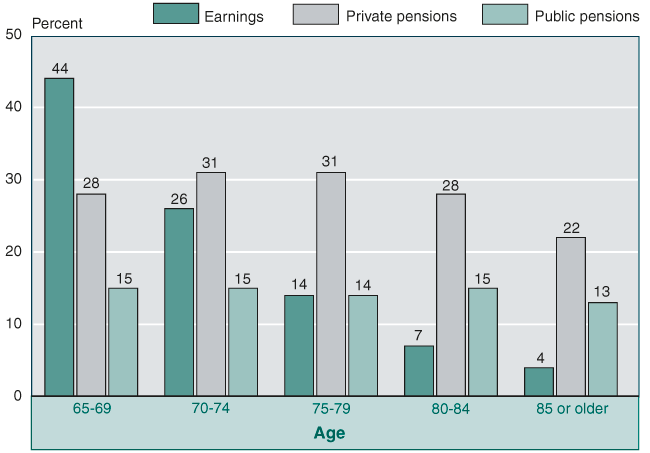
| Age | Earnings | Private pensions | Public pensions |
|---|---|---|---|
| 65–69 | 44 | 28 | 15 |
| 70–74 | 26 | 31 | 15 |
| 75–79 | 14 | 31 | 14 |
| 80–84 | 7 | 28 | 15 |
| 85 or older | 4 | 22 | 13 |
Receipt of income from major sources varies by race and Hispanic origin. Among the aged, whites and blacks are somewhat more likely than Hispanics to receive Social Security. Whites are much more likely than blacks or Hispanics to receive income from assets and from pensions. The groups are about equally as likely to have earnings. Minority aged units are much more likely to receive Supplemental Security Income (SSI) than are whites.
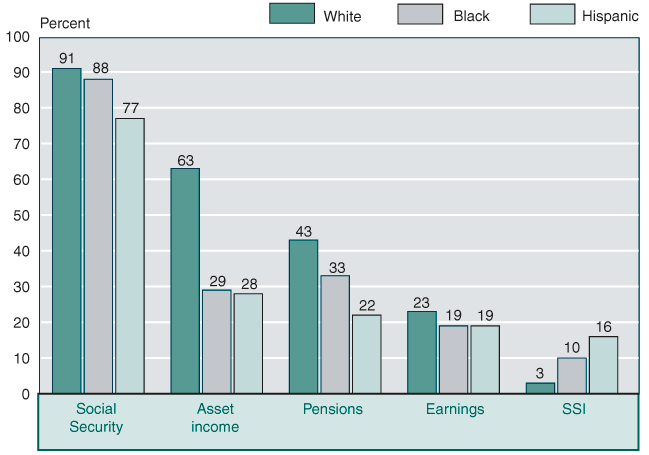
| Source of income | White | Black | Hispanic |
|---|---|---|---|
| Social Security | 91 | 88 | 77 |
| Asset income | 63 | 29 | 28 |
| Pensions | 43 | 33 | 22 |
| Earnings | 23 | 19 | 19 |
| Supplemental Security Income | 3 | 10 | 16 |
Receipt of Social Security has become nearly universal. In 1962, 69% of the aged received Social Security benefits; in 2000, 90% of them did. Most of that increase occurred in the 1960s. Receipt of other pension income, which more than doubled from 1962 to 1992, has decreased slightly since then. The proportion of aged units with asset income, which had been about two-thirds since 1980, has dropped since 1994. The proportion with earnings has declined since 1971 and has been about 21% since 1982. The proportion receiving public assistance has also declined and is now about a third of its 1962 level.
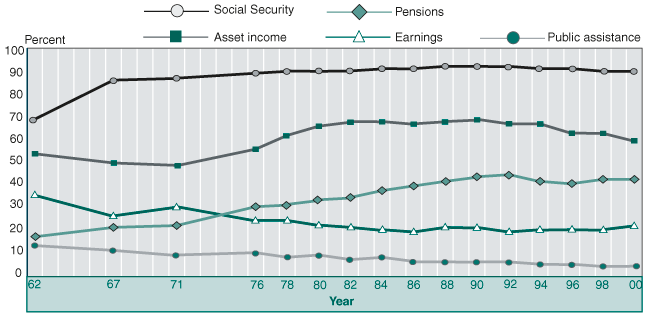
Total Money Income
- The aged are an economically diverse group.
- Income differences by age are associated with differences in marital status.
- Demographic differences are associated with different levels of income.
- Median real income has risen substantially over the years.
The aged are an economically diverse group. Median income for all aged units is $18,778, but there are wide differences within the total group. About 19% have an income of under $9,000 (compared with the 2000 poverty threshold of $8,259 for one person aged 65 or older), and 14% have an income of $50,000 or more.

| Median income (thousands of dollars) | Percentage of aged units |
|---|---|
| Less than 5 | 5 |
| 5-9 | 17 |
| 10-14 | 18 |
| 15-19 | 13 |
| 20-24 | 10 |
| 25-29 | 8 |
| 30-34 | 6 |
| 35-39 | 4 |
| 40-44 | 3 |
| 45-49 | 2 |
| 50 or more | 14 |
Receipt of asset income is associated with relatively high median income. The median income of aged units with asset income is more than twice that of those with no asset income ($25,974, compared with $11,536). Aged units with no asset income are concentrated in the lowest income categories—41% have a total income below $10,000, and only 11% have an income of $30,000 or more. Among aged units with asset income, 10% have a total income of less than $10,000, and 42% have an income of $30,000 or more.
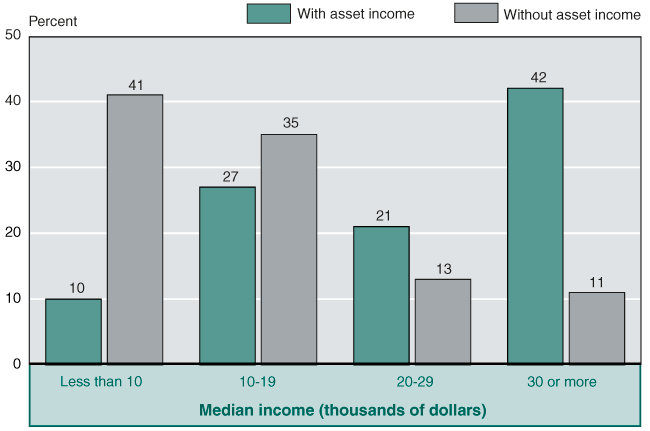
| Median income (thousands of dollars) |
With asset income | Without asset income |
|---|---|---|
| Less than 10 | 10 | 41 |
| 10–19 | 27 | 35 |
| 20–29 | 21 | 13 |
| 30 or more | 42 | 11 |
Receipt of earnings and retirement benefits also affects total income. About 7% of aged units have no retirement benefits. Of those, 39% have earnings, and their median income is $34,130; 61% have no earnings, and their median income is only $549. In the absence of earnings, median income rises markedly with the number of retirement benefits received, from $11,562 with one retirement benefit to $24,611 with two. For units with both earnings and retirement benefits, median income is $33,268 for those with one retirement benefit and $44,980 for those with two.
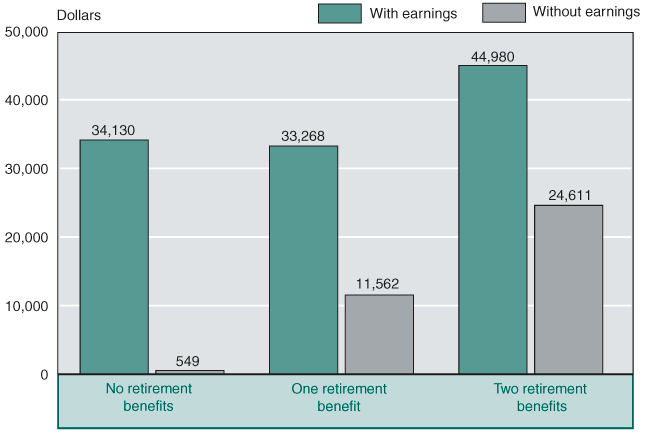
| Number of retirement benefits | Median income (dollars) | |
|---|---|---|
| With earnings | Without earnings | |
| No benefits | 34,130 | 549 |
| One benefit | 33,268 | 11,562 |
| Two benefits | 44,980 | 24,611 |
Income differences by age are associated with differences in marital status. Median income is generally lower in older age groups. The striking differences by age are due in part to the disproportionate number of nonmarried women in older age groups. In every age group, nonmarried women have a lower median income than nonmarried men or married couples. Also, nonmarried women far outnumber the others in the older age groups.
| Marital status and sex of nonmarried persons | 65-69 | 70-74 | 75-79 | 80-84 | 85 or older |
|---|---|---|---|---|---|
| Median income (dollars) | |||||
| Married couples | 36,948 | 32,012 | 27,723 | 27,206 | 24,779 |
| Nonmarried men | 19,128 | 14,678 | 15,715 | 16,247 | 13,764 |
| Nonmarried women | 13,415 | 12,269 | 12,020 | 12,335 | 10,910 |
| Percentage distribution of aged units | |||||
| Total percent | 100 | 100 | 100 | 100 | 100 |
| Married couples | 55 | 45 | 39 | 31 | 19 |
| Nonmarried men | 14 | 16 | 14 | 17 | 19 |
| Nonmarried women | 31 | 39 | 47 | 52 | 62 |
| Memorandum: Total number of aged units (thousands) |
6,508 | 6,154 | 5,689 | 3,841 | 3,038 |
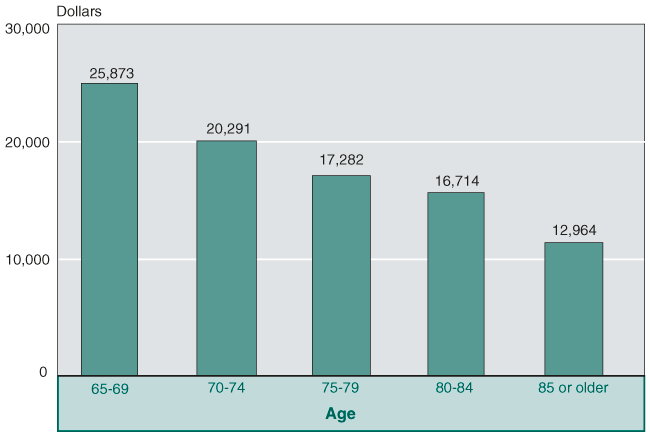
Demographic differences are associated with different levels of median income. Income is highest for married couples, who have a median income about twice that of nonmarried men and more than 2½ times that of nonmarried women. Whites have a median income 60% greater than that of blacks and almost 90% greater than that of Hispanics.

Median real income has risen substantially over the years. Between 1962 and 2000, the income of the aged increased even when adjusted for inflation. The increase was 91% for married couples and 98% for nonmarried persons. There were disproportionate increases by race. Between 1967 and 2000, the income of whites increased by 102%; that of blacks increased by 78%.
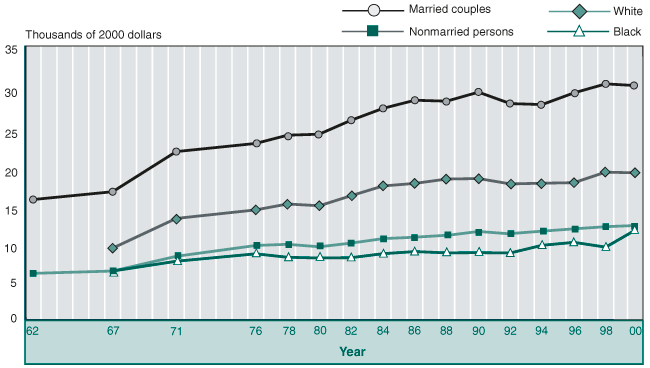
Shares of Aggregate Income
- Social Security provides the largest share of aggregate income for persons 65 or older.
- Shares of income from each source differ greatly by income level.
- Over time, Social Security has provided the largest share of aggregate income for the aged.
Social Security provides the largest share of income for the aged. Aggregate income for the population 65 or older comes largely from four sources. Social Security provides 38%, earnings account for 23%, and asset income and pensions each account for 18%. Only 3% comes from other sources.
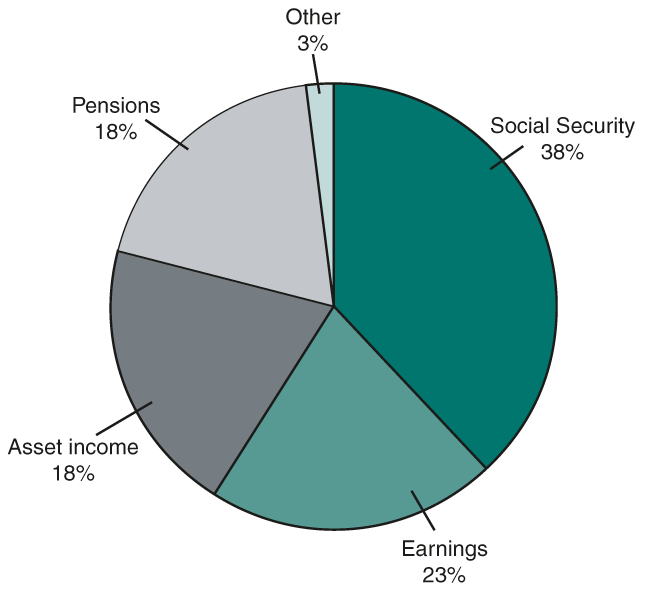
Shares of income from each source differ greatly by income level. Aged units are ranked by total money income and divided into five groups of equal size called quintiles. Persons in the lowest quintile have the largest share of income from Social Security benefits (82%), and public assistance provides the second largest share (8%). For those in the highest income quintile, earnings provide the largest share of income (35%), income from assets is the next most important (24%), followed by pensions (19%) and Social Security (19%).
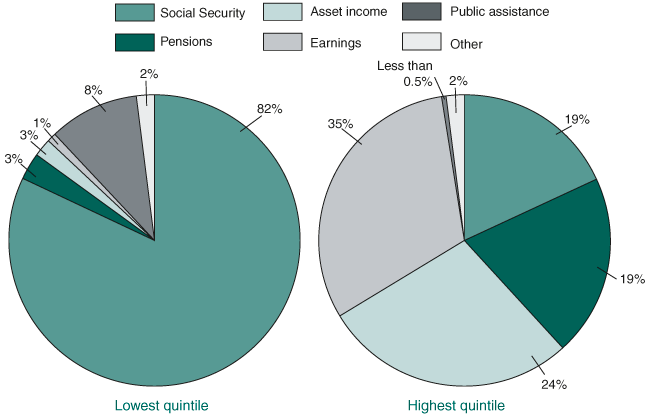
| Source of income | Percentage in lowest quintile |
Percentage in highest quintile |
|---|---|---|
| Social Security | 82 | 19 |
| Pensions | 3 | 19 |
| Asset income | 3 | 24 |
| Earnings | 1 | 35 |
| Public assistance | 8 | -0.5 |
| Other | 2 | 2 |
Over time, Social Security has provided the largest share of aggregate income for the aged. In 1962, it provided the largest share followed closely by earnings. In 2000, Social Security continued to provide the largest share but by a much wider margin compared with the other major sources of income. The share from asset income increased for over 20 years but has generally declined since the mid-1980s. The share from earnings has had the opposite pattern—declining until the mid-1980s and increasing since then. The share from pensions had doubled by the early 1990s but has since leveled off.
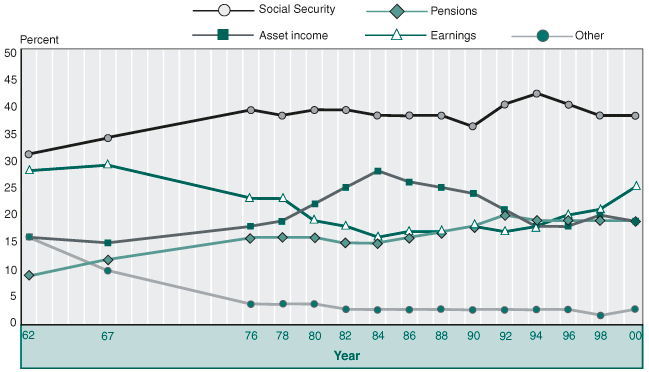
Poverty Status, Based on Family Income
- High proportions of nonmarried and minority aged are poor or near poor.
- The oldest age group (85 or older) has the highest poverty rate.
High proportions of nonmarried and minority aged are poor or near poor. The variations in family income by marital status and by race are reflected in the poverty rates for those subgroups of the aged. Nonmarried persons and minorities have the highest poverty rates, ranging from 15% to 22%. When those with income between the poverty line and 125% of the poverty line (the near poor) are included, the rates for nonmarried persons and minorities range from 24% to 31%.
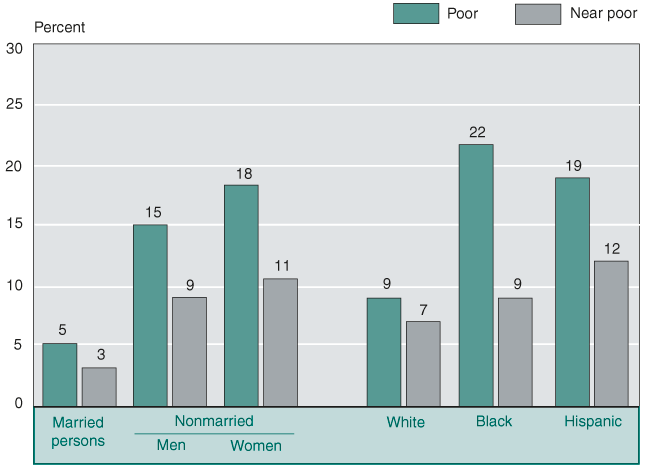
| Percentage poor | Percentage near poor | |
|---|---|---|
| Married persons | 5 | 3 |
| Nonmarried men | 15 | 9 |
| Nonmarried women | 18 | 11 |
| White | 9 | 7 |
| Black | 22 | 9 |
| Hispanic | 19 | 12 |
The oldest age group has the highest poverty rate. In keeping with the lower median income of older age groups, poverty rates are often higher for those who are older. As with income, the large proportion of nonmarried women in the older age groups contributes to the difference in poverty rates by age. Nonmarried women are more likely than married persons to be poor or near poor in every age group. The near poor have income between the poverty line and 125% of the poverty line.
| Age | Married persons |
Nonmarried men |
Nonmarried women |
|---|---|---|---|
| Percentage poor | |||
| 65–69 | 4 | 16 | 18 |
| 70–74 | 4 | 17 | 18 |
| 75–79 | 5 | 13 | 19 |
| 80–84 | 5 | 15 | 17 |
| 85 or older | 5 | 16 | 17 |
| Percentage poor or near poor | |||
| 65–69 | 7 | 23 | 27 |
| 70–74 | 8 | 27 | 29 |
| 75–79 | 9 | 20 | 30 |
| 80–84 | 9 | 27 | 27 |
| 85 or older | 11 | 25 | 33 |
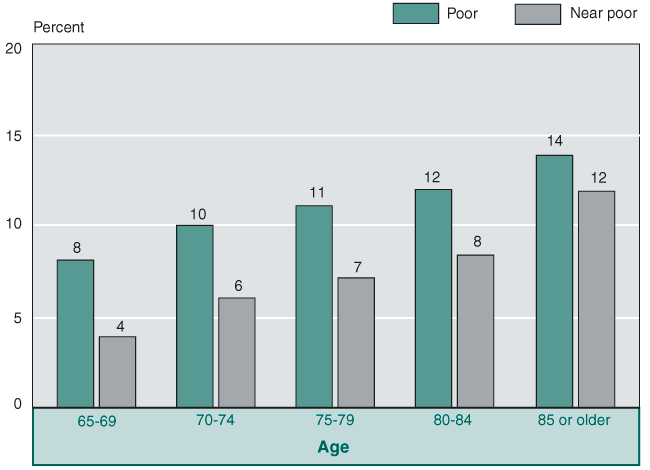
| Age | Percentage poor | Percentage near poor |
|---|---|---|
| 65–69 | 8 | 4 |
| 70–74 | 10 | 6 |
| 75–79 | 11 | 7 |
| 80–84 | 12 | 8 |
| 85 or older | 14 | 12 |